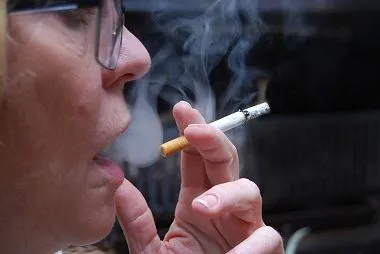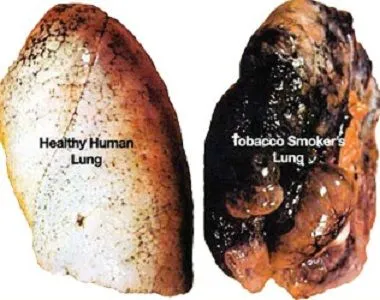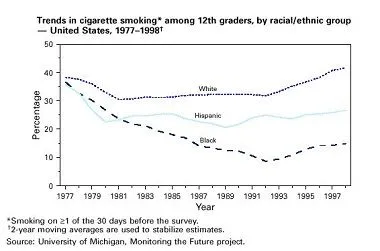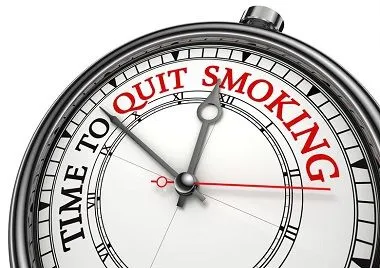
About 93 million sticks of cigarettes are produced yearly in Nigeria and every stick is consumed in the country. In Britain research has shown that more than three-quarter of men and half of women smoke cigarette.
In USA , it is reported that tobacco use kill more than 480,000 people each year much more than the total number killed by AIDS, alcohol, motor vehicles, homicide, illegal drugs and suicide combined. About 57% of all male death and nearly 50% of all female death are attributed to cigarette smoking.
Dried tobacco leaves is used to make spit and pipe tobacco, cigarettes and cigars, and in order to enhance the flavor or to make smoking more pleasant, more than hundreds of substances are added to cigarettes by manufacturers.
In the USA and majority of the western world, the most important source of preventing premature death and morbidity has been identified to be cessation of cigarette smoking. About 4000 nonsmoking adults die of diseases caused by exposure to second hand smoke every year. Secondhand refers to inhaling the exhaled smoke of a smoker and it causes coughing, phlegm, chest discomfort and reduced lung function in nonsmokers. Horizontal transmission of nicotine can occur from mothers who smoke to their children through breast milk.
Smokeless tobacco

WHO International Agency for Research on Cancer conducted a study in 2008 and concluded that people that uses smokeless tobacco have about 80% higher risk of developing oral cancer and about 60% risk of developing esophageal and pancreatic cancer .
Other health challenges of smokeless tobacco apart from cancer include diseases/lesions affecting the mouth, tooth decay, and adverse reproductive and developmental effects such as stillbirth, preterm birth, and low birth weight babies.
A study by the USA National Institutes of Health and the Centers for Disease Control and Prevention found that people that chew tobacco were four times more likely to have decayed dental root surfaces than non-users.
Studies have also found that the carcinogenic levels of Nitrosamine and polycyclic hydrocarbons in smokeless tobacco products were comparable to those of cigarettes and higher concentrations of nicotine and carcinogenic tobacco-specific nitrosamines were reported to be in smokeless tobacco users than in cigarette smokers.
Constituent of tobacco
There are over 4000 chemicals in tobacco, of these 400 have been identified as toxins and 43 are carcinogens. Some of these chemicals are;
- Nicotine
- Tar
- Carbon monoxide
- Nitrogen oxide
- Nitrosamines
- Ammonia
- Benzopyrene
- Hydrogen cyanide
- Metals – lead, polonium, cadminum
- Radio- active substances---Polonium 210
- Arsenic
- Acetone
- Formaldehyde
Nicotine
Nicotine is a naturally occurring liquid alkaloid with a chemical formula (C10H14N2) and it is a component of the tobacco leaf and present in cigarette in varying concentration. It is the primary psychoactive substance in tobacco. Its addictive processes and potential have been equated with heroine, morphine and cocaine. It is psychologically addictive
It acts on nicotinic acetylcholine receptors to release neurotransmitters such as dopamine, glutamate and gamma-aminobutyric acid (GABA). Dopamine when released induces a pleasurable effect that triggers positive reinforcement ( i.e the desire for more nicotine) and thus a craving for nicotine with repeated smoking especially when the nicotine concentration in the type of cigarette is low which makes the smoker to engage in chain smoking and draw more deeply in order to inhale large volume which invariably implies inhaling more of the other harmful components of cigarette smoke.

Nicotine acts at great speed and causes increase in heart rate and blood pressure, constriction of blood vessels, decrease chemotaxis and phagocytosis of neutrophilic and granulocytes. It also produces changes in the microflora of gingival pockets, gingival perfusion and affects healing process among many other effects.
Effects
Harmful effects of tobacco products are dose-dependent. They depend more on abuse than on simple use. The effects can manifest in two way;
- Nicotine addiction
- Cancer
Cancers

It is a major cause of cancer in the following parts of the body:
- Lung
- Larynx
- Oral cavity
- Pharynx
- Bladder
Smoking is also linked to the following cancers: - Pancreas
- Cervix
- Kidney
- Stomach
Reproductive effect
- There is reduced fertility and a higher risk of miscarriage,
- Early delivery (premature birth),
- Stillbirth, Infant death,
- Low birth-weight in infants.
- It has also been linked to sudden infant death syndrome (SIDS)
- Congenital defects e.g Cleft
- Erectile dysfuntion in males
Cardiovascular effects
- Nicotine increases heart rate and blood pressure and restricts blood flow to the heart muscle.
- Release of adrenalin and noradrenaline increases heart rate and blood pressure.
- It increases the viscosity of the blood as well as clot formation therefore aids atherosclerosis and thrombosis
- It increases Low Density Lipoprotein (LDL) cholesterol and decreases High Density Lipoprotein (HDL) cholesterol which leads to hardening of the arteries and hypertension
Psychosocial effects
Nicotine causes;
- Mood swings
- Irritability
- Stress
- Low self esteem
Oral effects
- Halitosis
- Stains
- Loss of sense of smell and taste
- Ulcerative gingivitis
- Chronic periodontitis
- Poor wound healing
- Candidiasis
- Hairy tongue
- Smokers melanosis
- Nicotinic palatinus
- Leukoplakia
- Oral cancers
Smoking Cessation
This is a strategy to reduce and combat morbidity and smoking related deaths due to tobacco use. Quitting of cigarette smoking is difficult but not impossible. An established addition to nicotine is difficult to escape, however it can take several quit attempts before being successful.
High rate of relapse has been reported in people who desire to quit and this occur in about 75-80% within 6months of quit. In order for smokers to quit smoking, they must not only overcome their physiological dependence on nicotine but also cut their strong psychological and social ties to smoking or otherwise using tobacco.

- To help make this a reality, WHO introduced the MPOWER measures which is intended to help in the implementation of the treaty at country level for effective intervention to reduce tobacco demand.
THE SIX COMPONENTS OF MPOWER: - Monitor tobacco use and prevention policies
- Protect people from tobacco smoke
- Offer help to quit tobacco use
- Warn about the dangers of tobacco
- Enforce bans on tobacco advertising, promotion and sponsorship
- Raise taxes on tobacco
There are two levels of intervention:
- Brief Opportunistic advice - mainly delivered during the course of routine consultation by a range of healthcare professionals;
- Specialist cessation interventions - delivering intensive advice and support, either on a one to one basis, or in groups, by individuals who have been specially trained and have the dedicated time to provide this service.
The 5 As of cessation
ASK
- Ask all patients about tobacco use/smoking status and document answers.
CURRENT SMOKER
EVER USED TOBACCO - Have you tried to stop in the past?
ADVISE
- Advise all smokers to stop.
- Advice should be clear enough to provide an unambiguous message to quit and strong enough by stressing the importance of quitting
- Personalized: tie tobacco use to current oral or other health problems and consequences; social, familial and economic costs; and motivation level or readiness to quit.
ASSESS
Determine willingness to make a quit attempt.
- Ask if tobacco user is willing to quit in the next 30days.
- Assess patient’s willingness to quit
- If patient is willing to make an attempt help the patient by encouraging him/her to participate in intensive treatment.
- If unwilling, provide a motivational intervention
- Additional information may be provided in cases where the patient is a member of a special population such as adolescent and pregnant woman.
Assist the patient in stopping
- Help to Set a date to quit within two weeks
- Set a quit date, ideally within two weeks
- Have patient tell family, friends and co-workers and ask for understanding and support.
- Anticipate challenges such as nicotine withdrawal symptoms, particularly during the critical first weeks
- Remove tobacco products from environment
- Before they quit, have patients avoid smoking where they spend a lot of time i.e workplace, home or car.
PROVIDE PRACTICAL COUNSELING, PROBLEM SOLVING AND SKILLS TRAINING

Withdrawal symptoms
When People who are addicted to nicotine stopped smoking, they tend to experience withdrawal symptoms. These symptoms include but not limited to anxiety, depressed mood, anger, difficulty concentrating, increased appetite, and craving for nicotine most of which will resolve or subside within 4weeks, except for hunger and craving which may persist for months.
Use of Nicotine Replacement Therapy (NPR) such as NORTRIPTYLINE, VARENICLINE (Chantix, Champix) and BUPROPION (Zyban).
Conclusion
Tobacco dependence is a chronic condition which leads to disease and death for smokers, and substantial costs for the public health system.Tobacco addiction is real and difficult to break but achievable.The cessation aids are to help but the real strength to quit lies with the patient.The benefits of quitting are numerous and far outweigh the challenges of quitting.
Thank you for reading.
Please note: All pictures used in this post are labelled for free usage